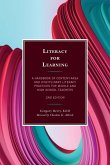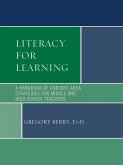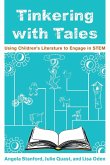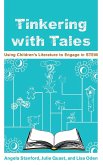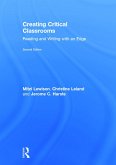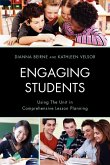Gregory Berry
Literacy for Learning
A Handbook of Content-Area and Disciplinary Literacy Practices for Middle and High School Teachers
Gregory Berry
Literacy for Learning
A Handbook of Content-Area and Disciplinary Literacy Practices for Middle and High School Teachers
- Gebundenes Buch
- Merkliste
- Auf die Merkliste
- Bewerten Bewerten
- Teilen
- Produkt teilen
- Produkterinnerung
- Produkterinnerung
- Weitere 7 Ausgaben:
- Gebundenes Buch
- Broschiertes Buch
- Broschiertes Buch
- eBook, ePUB
- eBook, ePUB
- eBook, PDF
- eBook, PDF
Literacy for Learning, 2nd edition, introduces a model of instruction for content area learning that moves from the science of reading to strategic reading, and then through content area literacy into disciplinary literacy. The updates to this edition include more recent scholarship, and a new digital component featuring resources and strategies.
Andere Kunden interessierten sich auch für
![Literacy for Learning Literacy for Learning]() Gregory BerryLiteracy for Learning57,99 €
Gregory BerryLiteracy for Learning57,99 €![Literacy for Learning Literacy for Learning]() Gregory BerryLiteracy for Learning75,99 €
Gregory BerryLiteracy for Learning75,99 €![Literacy for Learning Literacy for Learning]() Gregory BerryLiteracy for Learning135,99 €
Gregory BerryLiteracy for Learning135,99 €![Tinkering with Tales Tinkering with Tales]() Angela StanfordTinkering with Tales46,99 €
Angela StanfordTinkering with Tales46,99 €![Tinkering with Tales Tinkering with Tales]() Angela StanfordTinkering with Tales95,99 €
Angela StanfordTinkering with Tales95,99 €![Creating Critical Classrooms Creating Critical Classrooms]() Mitzi LewisonCreating Critical Classrooms203,99 €
Mitzi LewisonCreating Critical Classrooms203,99 €![Engaging Students Engaging Students]() Dianna P. BeirneEngaging Students40,99 €
Dianna P. BeirneEngaging Students40,99 €-
-
-
Literacy for Learning, 2nd edition, introduces a model of instruction for content area learning that moves from the science of reading to strategic reading, and then through content area literacy into disciplinary literacy. The updates to this edition include more recent scholarship, and a new digital component featuring resources and strategies.
Produktdetails
- Produktdetails
- Verlag: Rowman & Littlefield Publishers
- 2nd Edition
- Seitenzahl: 122
- Erscheinungstermin: 8. Dezember 2021
- Englisch
- Abmessung: 235mm x 157mm x 11mm
- Gewicht: 339g
- ISBN-13: 9781475861587
- ISBN-10: 1475861583
- Artikelnr.: 62221142
- Herstellerkennzeichnung
- Libri GmbH
- Europaallee 1
- 36244 Bad Hersfeld
- gpsr@libri.de
- Verlag: Rowman & Littlefield Publishers
- 2nd Edition
- Seitenzahl: 122
- Erscheinungstermin: 8. Dezember 2021
- Englisch
- Abmessung: 235mm x 157mm x 11mm
- Gewicht: 339g
- ISBN-13: 9781475861587
- ISBN-10: 1475861583
- Artikelnr.: 62221142
- Herstellerkennzeichnung
- Libri GmbH
- Europaallee 1
- 36244 Bad Hersfeld
- gpsr@libri.de
Gregory Berry
Preface
Acknowledgments
Introduction
Part I: Overview of Literacy Expectations in Middle and High School
Chapter 1. Nothing Happens in a Vacuum
Improved Academic Performance?
What Happened?
What is the Literacy Expectation in Middle and High School?
How Do Teachers Meet These Expectations?
Part II: Becoming College and Career Ready
Who Are These Freshmen?
Key Shifts Called for by the Common Core
Chapter 2. Strategic Reading and Writing
What Is Strategic Reading and Writing?
What Does Strategic Reading and Writing Look Like in a Classroom?
Strategic Readers and Writers Are Effective Readers and Writers
Chapter 3. Content-Area Literacy
The Next Step
Developing Content-Area Literacy
Instructor Response
Beyond Deep Learning
Chapter 4. Disciplinary Literacy
Creating Discourse Communities
Intentional Disciplinary Literacy
So, What Does Disciplinary Literacy Look Like?
Part III: A Literacy Model of Instruction Using Informational Texts
Chapter 5. Reading Across the Disciplines
Informational Texts
Recursive Reading and Writing to Learn
A Process for Reading Informational Texts
Before Reading: Preparing to Read and Write
During Reading: Responding in Writing While Reading
After Reading: Reinforcing, Expanding, and Writing
Adapting and Customizing
From Content-Area Literacy to Disciplinary Literacy
More Than a Process for Reading
Chapter 6. Academic Language Across the Disciplines
The Significance of Vocabulary
Brain Development and Vocabulary
Effective Vocabulary Instruction
Chapter 7. Writing Across the Disciplines
What is Content-Area Writing?
The Reading-Writing Connection
Informal Writing versus Formal Writing
Empowered Teachers Empower Students
Improving Writing through Mentor Texts
Part IV: Using Technology to Support Content-Area and Disciplinary Literacy
Chapter 8. Standards, Tenets, and Best Practices
Technology Standards
Basic Tenets of Technology in Education
Reading, Thinking, and Composing Digitally
Chapter 9. Instructional Resources
Libraries/Media Centers/Computer Labs
Open-Access Resources
Dependable, Credible Resources
References
About the Author
Acknowledgments
Introduction
Part I: Overview of Literacy Expectations in Middle and High School
Chapter 1. Nothing Happens in a Vacuum
Improved Academic Performance?
What Happened?
What is the Literacy Expectation in Middle and High School?
How Do Teachers Meet These Expectations?
Part II: Becoming College and Career Ready
Who Are These Freshmen?
Key Shifts Called for by the Common Core
Chapter 2. Strategic Reading and Writing
What Is Strategic Reading and Writing?
What Does Strategic Reading and Writing Look Like in a Classroom?
Strategic Readers and Writers Are Effective Readers and Writers
Chapter 3. Content-Area Literacy
The Next Step
Developing Content-Area Literacy
Instructor Response
Beyond Deep Learning
Chapter 4. Disciplinary Literacy
Creating Discourse Communities
Intentional Disciplinary Literacy
So, What Does Disciplinary Literacy Look Like?
Part III: A Literacy Model of Instruction Using Informational Texts
Chapter 5. Reading Across the Disciplines
Informational Texts
Recursive Reading and Writing to Learn
A Process for Reading Informational Texts
Before Reading: Preparing to Read and Write
During Reading: Responding in Writing While Reading
After Reading: Reinforcing, Expanding, and Writing
Adapting and Customizing
From Content-Area Literacy to Disciplinary Literacy
More Than a Process for Reading
Chapter 6. Academic Language Across the Disciplines
The Significance of Vocabulary
Brain Development and Vocabulary
Effective Vocabulary Instruction
Chapter 7. Writing Across the Disciplines
What is Content-Area Writing?
The Reading-Writing Connection
Informal Writing versus Formal Writing
Empowered Teachers Empower Students
Improving Writing through Mentor Texts
Part IV: Using Technology to Support Content-Area and Disciplinary Literacy
Chapter 8. Standards, Tenets, and Best Practices
Technology Standards
Basic Tenets of Technology in Education
Reading, Thinking, and Composing Digitally
Chapter 9. Instructional Resources
Libraries/Media Centers/Computer Labs
Open-Access Resources
Dependable, Credible Resources
References
About the Author
Preface
Acknowledgments
Introduction
Part I: Overview of Literacy Expectations in Middle and High School
Chapter 1. Nothing Happens in a Vacuum
Improved Academic Performance?
What Happened?
What is the Literacy Expectation in Middle and High School?
How Do Teachers Meet These Expectations?
Part II: Becoming College and Career Ready
Who Are These Freshmen?
Key Shifts Called for by the Common Core
Chapter 2. Strategic Reading and Writing
What Is Strategic Reading and Writing?
What Does Strategic Reading and Writing Look Like in a Classroom?
Strategic Readers and Writers Are Effective Readers and Writers
Chapter 3. Content-Area Literacy
The Next Step
Developing Content-Area Literacy
Instructor Response
Beyond Deep Learning
Chapter 4. Disciplinary Literacy
Creating Discourse Communities
Intentional Disciplinary Literacy
So, What Does Disciplinary Literacy Look Like?
Part III: A Literacy Model of Instruction Using Informational Texts
Chapter 5. Reading Across the Disciplines
Informational Texts
Recursive Reading and Writing to Learn
A Process for Reading Informational Texts
Before Reading: Preparing to Read and Write
During Reading: Responding in Writing While Reading
After Reading: Reinforcing, Expanding, and Writing
Adapting and Customizing
From Content-Area Literacy to Disciplinary Literacy
More Than a Process for Reading
Chapter 6. Academic Language Across the Disciplines
The Significance of Vocabulary
Brain Development and Vocabulary
Effective Vocabulary Instruction
Chapter 7. Writing Across the Disciplines
What is Content-Area Writing?
The Reading-Writing Connection
Informal Writing versus Formal Writing
Empowered Teachers Empower Students
Improving Writing through Mentor Texts
Part IV: Using Technology to Support Content-Area and Disciplinary Literacy
Chapter 8. Standards, Tenets, and Best Practices
Technology Standards
Basic Tenets of Technology in Education
Reading, Thinking, and Composing Digitally
Chapter 9. Instructional Resources
Libraries/Media Centers/Computer Labs
Open-Access Resources
Dependable, Credible Resources
References
About the Author
Acknowledgments
Introduction
Part I: Overview of Literacy Expectations in Middle and High School
Chapter 1. Nothing Happens in a Vacuum
Improved Academic Performance?
What Happened?
What is the Literacy Expectation in Middle and High School?
How Do Teachers Meet These Expectations?
Part II: Becoming College and Career Ready
Who Are These Freshmen?
Key Shifts Called for by the Common Core
Chapter 2. Strategic Reading and Writing
What Is Strategic Reading and Writing?
What Does Strategic Reading and Writing Look Like in a Classroom?
Strategic Readers and Writers Are Effective Readers and Writers
Chapter 3. Content-Area Literacy
The Next Step
Developing Content-Area Literacy
Instructor Response
Beyond Deep Learning
Chapter 4. Disciplinary Literacy
Creating Discourse Communities
Intentional Disciplinary Literacy
So, What Does Disciplinary Literacy Look Like?
Part III: A Literacy Model of Instruction Using Informational Texts
Chapter 5. Reading Across the Disciplines
Informational Texts
Recursive Reading and Writing to Learn
A Process for Reading Informational Texts
Before Reading: Preparing to Read and Write
During Reading: Responding in Writing While Reading
After Reading: Reinforcing, Expanding, and Writing
Adapting and Customizing
From Content-Area Literacy to Disciplinary Literacy
More Than a Process for Reading
Chapter 6. Academic Language Across the Disciplines
The Significance of Vocabulary
Brain Development and Vocabulary
Effective Vocabulary Instruction
Chapter 7. Writing Across the Disciplines
What is Content-Area Writing?
The Reading-Writing Connection
Informal Writing versus Formal Writing
Empowered Teachers Empower Students
Improving Writing through Mentor Texts
Part IV: Using Technology to Support Content-Area and Disciplinary Literacy
Chapter 8. Standards, Tenets, and Best Practices
Technology Standards
Basic Tenets of Technology in Education
Reading, Thinking, and Composing Digitally
Chapter 9. Instructional Resources
Libraries/Media Centers/Computer Labs
Open-Access Resources
Dependable, Credible Resources
References
About the Author


